Validity of the Apatite/Merrillite Relationship in Evaluating the Water Content in the Martian Mantle: Implications from Shergottite Northwest Africa (NWA) 2975
Abstract
:1. Introduction
2. Reasoning for the Selection of NWA 2975 and the Current State of NWA 2975 Research
3. Analytical Approach
3.1. Sample Description
3.2. EPMA (Electron Probe Microanalysis)
3.3. EDS (Energy Dispersive Spectrometry) Mapping
3.4. LA-ICP-MS (Laser Ablation Inductively Coupled Plasma Mass Spectrometry)
3.5. TEM (Transmission Electron Microscope) Analysis
3.6. CL (Cathodoluminescence)
4. Results
4.1. CL Data
4.2. Phosphate Composition
4.3. TEM
5. Discussion
6. Implications
Supplementary Materials
Acknowledgments
Author Contributions
Conflicts of Interest
References
- Rubin, A.E. Mineralogy of meteorite groups. Meteorit. Planet. Sci. 1997, 32, 231–247. [Google Scholar] [CrossRef]
- McSween, H.Y., Jr.; Treiman, A.H. Martian meteorites. In Planetary Materials; Papike, J.J., Ed.; Reviews in Mineralogy and Geochemistry; Mineralogical Society of America: Chantilly, VA, USA, 1998; Volume 36, pp. 601–654. ISBN 0-939950-46-4. [Google Scholar]
- Piccoli, P.M.; Candela, P.A. Apatite in igneous systems. In Phosphates: Geochemical, Geobiological, and Materials Importance; Kohn, M.J., Rakovan, J., Hughes, J.M., Eds.; Reviews in Mineralogy and Geochemistry; Mineralogical Society of America: Washington, DC, USA, 2002; Volume 48, pp. 255–292. ISBN 0-939950-60-X. [Google Scholar]
- Hughes, J.M.; Jolliff, B.L.; Gunter, M.E. The atomic arrangement of merrillite from the Fra Mauro formation, Apollo 14 lunar mission: The first structure of merrillite from the Moon. Am. Mineral. 2006, 91, 1547–1552. [Google Scholar] [CrossRef]
- Hughes, J.M.; Jolliff, B.L.; Rakovan, J. The crystal chemistry of whitlockite and merrillite and the dehydrogenation of whitlockite to merrillite. Am. Mineral. 2008, 93, 1300–1305. [Google Scholar] [CrossRef]
- Jolliff, B.L.; Hughes, J.M.; Freeman, J.J.; Zeigler, R.A. Crystal chemistry of lunar merrillite and comparison to other meteoritic and planetary suites of whitlockite and merrillite. Am. Mineral. 2006, 91, 1583–1595. [Google Scholar] [CrossRef]
- Patiño Douce, A.E.; Roden, M. Apatite as a probe of halogen and water fugacities in the terrestrial planets. Geochim. Cosmochim. Acta 2006, 70, 3173–3196. [Google Scholar] [CrossRef]
- McCubbin, F.M.; Nekvasil, H. Maskelynite-hosted apatite in the Chassigny meteorite: Insight into late-stage magmatic volatile evolution in martian magmas. Am. Mineral. 2008, 93, 676–684. [Google Scholar] [CrossRef]
- Patiño Douce, A.E.; Roden, M.; Chaumba, J.; Fleisher, C.; Yogodzinski, G. Compositional variability of terrestrial mantle apatites, thermodynamic modeling of apatite volatile contents, and the halogen and water budgets of planetary mantles. Chem. Geol. 2011, 288, 14–31. [Google Scholar] [CrossRef]
- Shearer, C.K.; Burger, P.; Papike, J.; Sharp, Z.; McKeegan, K.D. Fluids on differentiated asteroids: Evidence for phosphates in differentiated meteorites GRA 06128 and GRA 06129. Meteorit. Planet. Sci. 2011, 46, 1345–1362. [Google Scholar] [CrossRef]
- McCubbin, F.M.; Hauri, E.H.; Elardo, S.M.; Van der Kaaden, K.E.; Wang, J.; Shearer, C.K. Hydrous melting of the martian mantle produced both depleted and enriched shergottites. Geology 2012, 40, 683–686. [Google Scholar] [CrossRef]
- McCubbin, F.M.; Shearer, C.K.; Burger, P.V.; Hauri, E.H.; Wang, J.; Elardo, S.M.; Papike, J.J. Volatile abundances of coexisting merrillite and apatite in the martian meteorite Shergotty: Implications for merrillite in hydrous magmas. Am. Mineral. 2014, 99, 1347–1354. [Google Scholar] [CrossRef]
- Lesnov, F.P. Consistent pattern of rare earth elements distribution in accessory minerals from rocks of mafic-ultramafic complexes. Open Geosci. 2013, 5, 112–173. [Google Scholar] [CrossRef]
- Santos, A.R.; Agee, C.B.; McCubbin, F.M.; Shearer, C.K.; Burger, P.V.; Sharp, Z.D.; Zimmer, M. Apatite and merrillite from martian meteorite NWA 7034. In LPI Contribution No. 1719, Proceedings of the 44th Lunar and Planetary Science Conference, The Woodlands, TX, USA, 18–22 March 2013; Lunar and Planetary Institute: Houston, TX, USA, 2013; Abstract number: 2601. [Google Scholar]
- Boyce, J.W.; Tomlinson, S.M.; McCubbin, F.M.; Greenwood, J.P.; Treiman, A.H. The Lunar Apatite Paradox. Science 2014, 344, 400–402. [Google Scholar] [CrossRef] [PubMed]
- Liu, Y.; Ma, C.; Beckett, J.R.; Chen, Y.; Guan, Y. Rare-earth-element minerals in martian breccia meteorites NWA 7034 and 7533: Implications for fluid–rock interaction in the martian crust. Earth Planet. Sci. Lett. 2016, 451, 251–262. [Google Scholar] [CrossRef]
- Adcock, C.T.; Tschauner, O.; Hausrath, E.M.; Udry, A.; Luo, S.N.; Cai, Y.; Ren, M.; Lanzirotti, A.; Newville, M.; Kunz, M.; Lin, C. Shock-transformation of whitlockite to merrillite and the implications for meteoritic phosphate. Nat. Commun. 2017, 8, 14667. [Google Scholar] [CrossRef] [PubMed]
- Balta, J.B.; McSween, H.Y., Jr. Water and the composition of Martian magmas. Geology 2013, 41, 1115–1118. [Google Scholar] [CrossRef]
- Filiberto, J.; Gross, J.; McCubbin, F.M. Constraints on the water, chlorine, and fluorine content of the Martian mantle. Meteorit. Planet. Sci. 2016, 51, 2023–2035. [Google Scholar] [CrossRef]
- Shearer, C.K.; Burger, P.V.; Papike, J.J.; McCubbin, F.M.; Bell, A.S. Crystal chemistry of merrillite from Martian meteorites: Mineralogical recorders of magmatic processes and planetary differentiation. Meteorit. Planet. Sci. 2015, 50, 649–673. [Google Scholar] [CrossRef]
- McCubbin, F.M.; Boyce, J.W.; Srinivasan, P.; Santos, A.R.; Elardo, S.M.; Filiberto, J.; Steele, A.; Shearer, C.K. Heterogeneous distribution of H2O in the Martian interior: Implications for the abundance of H2O in depleted and enriched mantle sources. Meteorit. Planet. Sci. 2016, 51, 2036–2060. [Google Scholar] [CrossRef]
- Xie, X.; Minitti, M.E.; Chen, M.; Wang, D.; Mao, H.; Shu, J.; Fei, Y. Natural high-pressure polymorph of merrillite in the shock vein of the Suizhou meteorite. Geochim. Cosmochim. Acta 2002, 66, 2439–2444. [Google Scholar] [CrossRef]
- Xie, X.; Minitti, M.E.; Chen, M.; Mao, H.; Wang, D.; Shu, J.; Fei, Y. Tuite, γ-Ca3(PO4)2: A New mineral from Suizhou L6 chondrite. Eur. J. Mineral. 2003, 15, 1001–1005. [Google Scholar] [CrossRef]
- Xie, X.; Zhai, S.; Chen, M.; Yang, H. Tuite, γ-Ca3(PO4)2, formed by chlorapatite decomposition in a shock vein of the Suizhou L6 chondrite. Meteorit. Planet. Sci. 2013, 48, 1515–1523. [Google Scholar] [CrossRef]
- Llorca, J.; Trigo-Rodríguez, J.M. Raman spectroscopy of merrillite in Villalbetode la Peña L6 ordinary chondrite. In LPI Contribution No. 1303, Proceedings of the 37th Lunar and Planetary Science Conference, League City, Texas, USA, 13–17 March 2006; Lunar and Planetary Institute: Houston, TX, USA, 2006; Abstract number: 1055. [Google Scholar]
- Howarth, G.H.; Pernet-Fisher, J.F.; Bodnar, R.J.; Taylor, L.A. Evidence for the exsolution of Cl-rich fluids in martian magmas: Apatite petrogenesis in the enriched lherzolitic shergottite Northwest Africa 7755. Geochim. Cosmochim. Acta 2015, 166, 234–248. [Google Scholar] [CrossRef]
- Jolliff, B.L.; Haskin, L.A.; Colson, R.O.; Wadhwa, M. Partitioning in REE-saturating minerals: Theory, experiment, and modeling of whitlockite, apatite, and evolution of lunar residual magmas. Geochim. Cosmochim. Acta 1993, 57, 4069–4094. [Google Scholar] [CrossRef]
- Filiberto, J.; Treiman, A.H. Martian magmas contained abundant chlorine, but little water. Geology 2009, 37, 1087–1090. [Google Scholar] [CrossRef]
- Wittke, J.H.; Bunch, T.E.; Irving, A.J.; Farmer, M.; Strope, J. Northwest Africa 2975: An evolved basaltic shergottite with vesicular glass pockets and trapped melt inclusions. In LPI Contribution No. 1303, Proceedings of the 37th Lunar and Planetary Science Conference, League City, TX, USA, 13–17 March 2006; Lunar and Planetary Institute: Houston, TX, USA, 2006; Abstract number: 1368. [Google Scholar]
- He, Q.; Hsu, W.; Xiao, L.; Guan, Y. Petrography and geochemistry of the shergottite Northwest Africa 2975. In LPI Contribution No. 1608, Proceedings of the 42nd Lunar and Planetary Science Conference, The Woodlands, Texas, USA, 7–11 March 2011; Lunar and Planetary Institute: Houston, TX, USA, 2011; Abstract number: 1646. [Google Scholar]
- Channon, M.B.; Boyce, J.W.; Stolper, E.M.; Eiler, J.M. Abundances of Cl, F, H, and S in apatites from martian meteorites. In LPI Contribution No. 1659, Proceedings of the 43rd Lunar and Planetary Science Conference, The Woodlands, Texas, USA, 19–23 March 2012; Lunar and Planetary Institute: Houston, TX, USA, 2012; Abstract number: 2845. [Google Scholar]
- Channon, M.B.; Boyce, J.W.; Stolper, E.M.; Eiler, J.M. Abundances of Cl, F, H, and S in apatites from SNC meteorites. In Meteoritics & Planetary Science, Proceedings of the 74th Annual Meeting of the Meteoritical Society, London, U.K. 8–12 August 2011; The Meteoritical Society: Chantilly, VA, USA, 2011; Volume 46, Abstract number: 5401. [Google Scholar]
- Tartèse, R.; Anand, M.; McCubbin, F.M.; Elardo, S.M.; Shearer, C.K.; Franchi, I.A. Apatites in lunar KREEP basalts: The missing link to understand the H isotope systematics of the Moon. Geology 2014, 42, 363–366. [Google Scholar] [CrossRef]
- McCubbin, F.M.; Jones, R.H. Extraterrestrial Apatite: Planetary Geochemistry to Astrobiology. Elements 2015, 11, 183–189. [Google Scholar] [CrossRef]
- Mikouchi, T.; Miyamato, M.; McKay, G.A. Mineralogy of Antarctic basaltic shergottite Queen Alexandra Range 94201: Mineralogical similarities to Elephant Moraine A79001 (lithology B) Martian meteorite. Meteorit. Plant. Sci. 1998, 33, 181–189. [Google Scholar] [CrossRef]
- Herd, C.D.K.; Treiman, A.H.; McKay, G.A.; Shearer, C.K. The behavior of Li and B during planetary basalt crystallization. Am. Mineral. 2004, 89, 832–840. [Google Scholar] [CrossRef]
- Channon, M.B. Oxygen Isotopes and Volatiles in Martian Meteorites. Ph.D Thesis, California Institute of Technology, Pasadena, CA, USA, 2013. [Google Scholar]
- Shearer, C.K.; Papike, J.J.; Burger, P.V.; Sutton, S.R.; McCubbin, F.M.; Newville, M. Direct determination of europium valence state by XANES in extraterrestrial merrillite: Implications for REE crystal chemistry and martian magmatism. Am. Mineral. 2011, 96, 1418–1421. [Google Scholar] [CrossRef]
- Howarth, G.H.; Liu, Y.; Chen, Y.; Pernet-Fisher, J.N.; Taylor, L.A. Postcrystallization metasomatism in shergottites: Evidence from the paired meteorites LAR 06319 and LAR 12011. Meteorit. Planet. Sci. 2016, 51, 2061–2072. [Google Scholar] [CrossRef]
- McCubbin, F.M.; Elardo, S.M.; Shearer, C.K.; Smirnov, A.; Hauri, E.H.; Draper, D.S. A petrogenetic model for the comagmatic origin of chassignites and nakhlites: Inferences from chlorine-rich minerals, petrology, and geochemistry. Meteorit. Planet. Sci. 2013, 48, 819–853. [Google Scholar] [CrossRef]
- He, Q.; Xiao, L.; Balta, J.B.; Baziotis, I.P.; Hsu, W.; Guan, Y. Petrography and geochemistry of the enriched basaltic shergottite Northwest Africa 2975. Meteorit. Planet. Sci. 2015, 50, 2024–2044. [Google Scholar] [CrossRef]
- Słaby, E.; Koch-Müller, M.; Förster, H-J.; Wirth, R.; Rhede, D.; Schreiber, A.; Schade, U. Determination of volatile concentrations in fluorapatite of Martian shergottite NWA 2975 by combining synchrotron FTIR, Raman spectroscopy, EMPA, and TEM, and inferences on the volatile budget of the apatite host-magma. Meteorit. Planet. Sci. 2016, 51, 1–17. [Google Scholar] [CrossRef]
- Lindsay, F.N.; Osmond, J.; Delaney, J.S.; Herzog, G.F.; Turrin, B.; Park, J.; Swisher, C.C. III Ar/Ar systematics of Martian meteorite NWA 2975. In LPI Contribution No. 1719, Proceedings of the 44th Lunar and Planetary Science Conference, The Woodlands, TX, USA, 18–22 March 2013; Lunar and Planetary Institute: Houston, TX, USA, 2013; Abstract number: 2911. [Google Scholar]
- Müller, W.; Shelley, M.; Miller, P.; Broude, S. Initial performance metrics of a new custom-designed ArF excimer LA-ICPMS system coupled to a two-volume laserablation cell. J. Anal. At. Spectrom. 2009, 24, 209–214. [Google Scholar] [CrossRef]
- Pearce, N.J.G.; Perkins, W.T.; Westgate, J.A.; Gorton, M.P.; Jackson, S.E.; Neal, C.R.; Chenery, P. A Compilation of New and Published Major and Trace Element Data for NIST SRM 610 and NIST SRM 612 Glass Reference Materials. Geostandard Newslett. 1997, 21, 115–144. [Google Scholar] [CrossRef]
- Wirth, R. Focused Ion Beam (FIB): A novel technology for advanced application of micro- and nanoanalysis in geosciences and applied mineralogy. Eur. J. Mineral. 2004, 16, 863–876. [Google Scholar] [CrossRef]
- Wirth, R. Focused Ion Beam (FIB) combined with SEM and TEM: Advanced analytical tools for studies of chemical composition, microstructure and crystal structure in geomaterials on a nanometre scale. Chem. Geol. 2009, 261, 217–229. [Google Scholar] [CrossRef]
- Kayama, M.; Nishido, H.; Sekine, T.; Nakazato, T.; Gucsik, A.; Ninagawa, K. Shock barometer using cathodoluminescence of alkali feldspar. J. Geophys. Res. 2012, 117, 1–13. [Google Scholar] [CrossRef]
- Irber, W. The lanthanide tetrad effect and its correlation with K/Rb, Eu/Eu*, Sr/Eu, Y/Ho and Zr/Hf of evolving peraluminous granite suits. Geochim. Cosmochim. Acta 1999, 63, 489–508. [Google Scholar] [CrossRef]
- Greenwood, J.P.; Itoh, S.; Sakamoto, N.; Vicenzi, E.P.; Yurimoto, H. Hydrogen isotope evidence for loss of water from Mars through time. Geophys. Res. Lett. 2008, 35, L05203. [Google Scholar] [CrossRef]
- Holland, H.D. Granites, solutions, and base metal deposits. Econ. Geol. 1972, 67, 281–301. [Google Scholar] [CrossRef]
- Kilinc, I.A.; Burnham, C.W. Partitioning of chloride between a silicate melt and coexisting aqueous phase from 2 to 8 kbar. Econ. Geol. 1972, 67, 231–235. [Google Scholar] [CrossRef]
- Candela, P.A. Toward a thermodynamic model for the halogens in magmatic systems-an application to melt vapor apatite equilibria. Chem. Geol. 1986, 57, 289–301. [Google Scholar] [CrossRef]
- Carroll, M.R.; Webster, J.D. Solubilities of sulfur, noble gases, nitrogen, chlorine, and fluorine in magmas. Rev. Mineral. Geochem. 1994, 30, 231–279. [Google Scholar]
- Webster, J.D.; Kinzler, R.J.; Mathez, E.A. Chloride and water solubility in basalt and andesite melts and implications for magmatic degassing. Geochim. Cosmochim. Acta 1999, 63, 729–738. [Google Scholar] [CrossRef]
- Ustunisik, G.; Nekvasil, H.; Lindsley, D. Differential degassing of H2O, Cl, F, and S: Potential effects on lunar apatite. Am. Mineral. 2011, 96, 1650–1653. [Google Scholar] [CrossRef]
- Ustunisik, G.; Nekvasil, H.; Lindsley, D.H.; McCubbin, F.M. Degassing pathways of Cl-, F-, H-, and S-bearing magms near lunar surface: Implications for the composition and Cl isotopic values of lunar apatite. Am. Mineral. 2015, 100, 1717–1727. [Google Scholar] [CrossRef]
- McCubbin, F.M.; Vander Kaaden, K.E.; Whitson, E.S.; Bell, A.S.; Shearer, C.K., Jr. Partitioning of F and Cl between apatite and a synthetic shergottite liquid (QUE 94201) at 1 and 4 GPa from 950 to 1450° C. In LPI Contribution No. 1719, Proceedings of the 44th Lunar and Planetary Science Conference, The Woodlands, TX, USA, 18–22 March 2013; Lunar and Planetary Institute: Houston, TX, USA, 2013; Abstract number: 2748. [Google Scholar]
- Vander Kaaden, K.E.; McCubbin, F.M.; Whitson, E.S.; Hauri, E.H.; Wang, J. Partitioning of F, Cl, and H2O between apatite and a synthetic shergottite liquid (QUE 94201) at 1.0 GPa and 990–1000 °C. In LPI Contribution No. 1659, Proceedings of the 43rd Lunar and Planetary Science Conference, The Woodlands, TX, USA, 19–23 March 2012; Lunar and Planetary Institute: Houston, TX, USA, 2012; Abstract number: 1247. [Google Scholar]
- Ferdous, J.; Brandon, A.D.; Peslier, A.H.; Pirotte, Z. Evaluating crustal contributions to enriched shergottites from the petrology, trace elements, and Rb-Sr and Sm-Nd isotope systematic of Northwest Africa 856. Geochim. Cosmochim. Acta 2017, 211, 280–306. [Google Scholar] [CrossRef]
- Murrell, M.T.; Brandriss, M.; Woolum, D.S.; Burnett, D.S. Pu-REE-Y partitioning between apatite and whitlockite. In LPI Contribution No. 1581, Proceedings of the 15th Lunar and Planetary Science Conference, Houston, TX, USA, 12–16 March 1984; Lunar and Planetary Institute: Houston, TX, USA, 1984; pp. 579–580, Abstract number: 1294. [Google Scholar]
- Webster, J.D.; Tappen, C.M.; Mandewille, C.W. Partitioning behavior of chlorine and fluorine in the system apatite-melt-fluid. II: Felsic silicate system at 200 MPa. Geochim. Cosmochim. Acta 2009, 73, 559–581. [Google Scholar] [CrossRef]
- Webster, J.D.; Rebbert, C.R. Experimental investigation of H2O and Cl- solubilities in F-enriched silicate liquids; implications for volatile saturation of topaz rhyolite magmas. Contrib. Mineral. Petrol. 1998, 132, 198–207. [Google Scholar] [CrossRef]
- Mathez, E.A.; Webster, J.D. Partitioning behavior of chlorine and fluorine in the system apatite–silicate melt–fluid. Geochim. Cosmochim. Acta 2005, 69, 1275–1286. [Google Scholar] [CrossRef]
- Boudreau, A.E.; McCallum, I.S. Investigations of the Stillwater Complex: Part V. Apatites as indicators of evolving fluid composition. Contrib. Mineral. Petrol. 1989, 102, 138–153. [Google Scholar] [CrossRef]
- Boudreau, A.E.; McCallum, I.S. Infiltration metasomatism in layered intrusions—An example from the Stillwater Complex, Montana. J. Volcanol. Geotherm. Res. 1992, 52, 171–183. [Google Scholar] [CrossRef]
- Lieftink, D.J.; Nijland, T.G.; Maijer, C. The behavior of rare-earth elements in high-temperature Cl-bearing aqueous fluids-Resaults from the Odegarden-Verk natural laboratory. Can. Mineral. 1994, 32, 149–158. [Google Scholar]
- Stadler, R.; Foley, S.F.; Brey, G.P.; Horn, I. Minieral aqueous fluid partitioning of trace elements at 900–1200 °C and 3.0–5.7 GPa: New experimental data for garnet, clinopyroxene, and rutile, and implications for mantle metasomatism. Geochim. Cosmochim. Acta 1998, 62, 1781–1801. [Google Scholar] [CrossRef]
- Mayanovic, R.A.; Anderson, A.J.; Basset, W.A.; Chou, I.M. The structure and stability of aqueous rare-earth elements in hydrothermal fluids: New results on neodymium(III) aqua and chloroaqua complexes in aqueous solutions to 500 degrees C and 520 MPa. Chem. Geol. 2009, 259, 30–38. [Google Scholar] [CrossRef]
- Bellucci, J.J.; Whitehouse, M.J.; John, T.; Nemchin, A.A.; Snape, J.F.; Bland, P.A.; Benedix, G.K. Halogen and Cl isotopic systematics in Martian phosphates: Implications for the Cl cycle and surface halogen reservoirs on Mars. Earth and Planet. Sci. Lett. 2017, 458, 192–202. [Google Scholar] [CrossRef]
- Ayers, J.C.; Watson, E.B. Apatite/fluid partitioning of rare earth elements and strontium: Experimental results at 1.0 GPa and 1000 °C and application to models of fluid/rock interaction. Chem. Geol. 1993, 110, 299–314. [Google Scholar] [CrossRef]
- Chu, M.-F.; Wand, K.-L.; Griffin, W.L.; Chung, S.-L.; O’Reilly, S.Y.; Pearson, N.J.; Iizuka, Y. Apatite composition: Tracing petrogenetic processes in Transhimalayan granitoids. J. Petrol. 2009, 50, 1829–1855. [Google Scholar] [CrossRef]
- Boyce, J.W.; Hervig, R.L. Magmatic degassing histories from apatite volatile stratigraphy. Geology 2008, 36, 63–66. [Google Scholar] [CrossRef]
- Hovis, G.L.; Harlov, D. Solution calorimetric investigation of fluor-chlorapatite crystalline solutions. Am. Mineral. 2010, 95, 946–952. [Google Scholar] [CrossRef]
- Harlov, D.E.; Wirth, R.; Förster, H.-J. An experimental study of dissolution reprecipitation in fluorapatite: Fluid infiltration and the formation of monazite. Contrib. Mineral. Petrol. 2005, 150, 268–286. [Google Scholar] [CrossRef]
- Hovis, G.L.; McCubbin, F.M.; Nekvasil, H.; Ustunisik, G.; Woerner, W.R.; Lindsley, D.H. A novel Technique for fluorapatite synthesis and the thermodynamic mixing behavior of F-OH apatite crystalline solutions. Am. Mineral. 2014, 99, 890–897. [Google Scholar] [CrossRef]
- Brenan, J. Kinetics of fluorine, chlorine and hydroxyl exchange in fluorapatite. Chem. Geol. 1993, 110, 195–210. [Google Scholar] [CrossRef]
- Higashi, Y.; Itoh, S.; Hashiguchi, M.; Sakata, S.; Hirata, T.; Watanabe, K.; Sakaguchi, I. Hydrogen diffusion in the apatite-water system: Fluorapatite parallel to the c-axis. Geochem. J. 2017, 51, 115–122. [Google Scholar] [CrossRef]
- Adcock, C.T.; Tschauner, O.; Hausrath, E.M. An investigation of shock effects on Mars-relevant phosphate minerals: Shock-transformation of chlorapatite. In LPI Contribution No. 1903, Proceedings of the 47th Lunar and Planetary Science Conference, The Woodlands, TX, USA, 21–25 March 2016; Lunar and Planetary Institute: Houston, TX, USA, 2016; Abstract number: 1577. [Google Scholar]
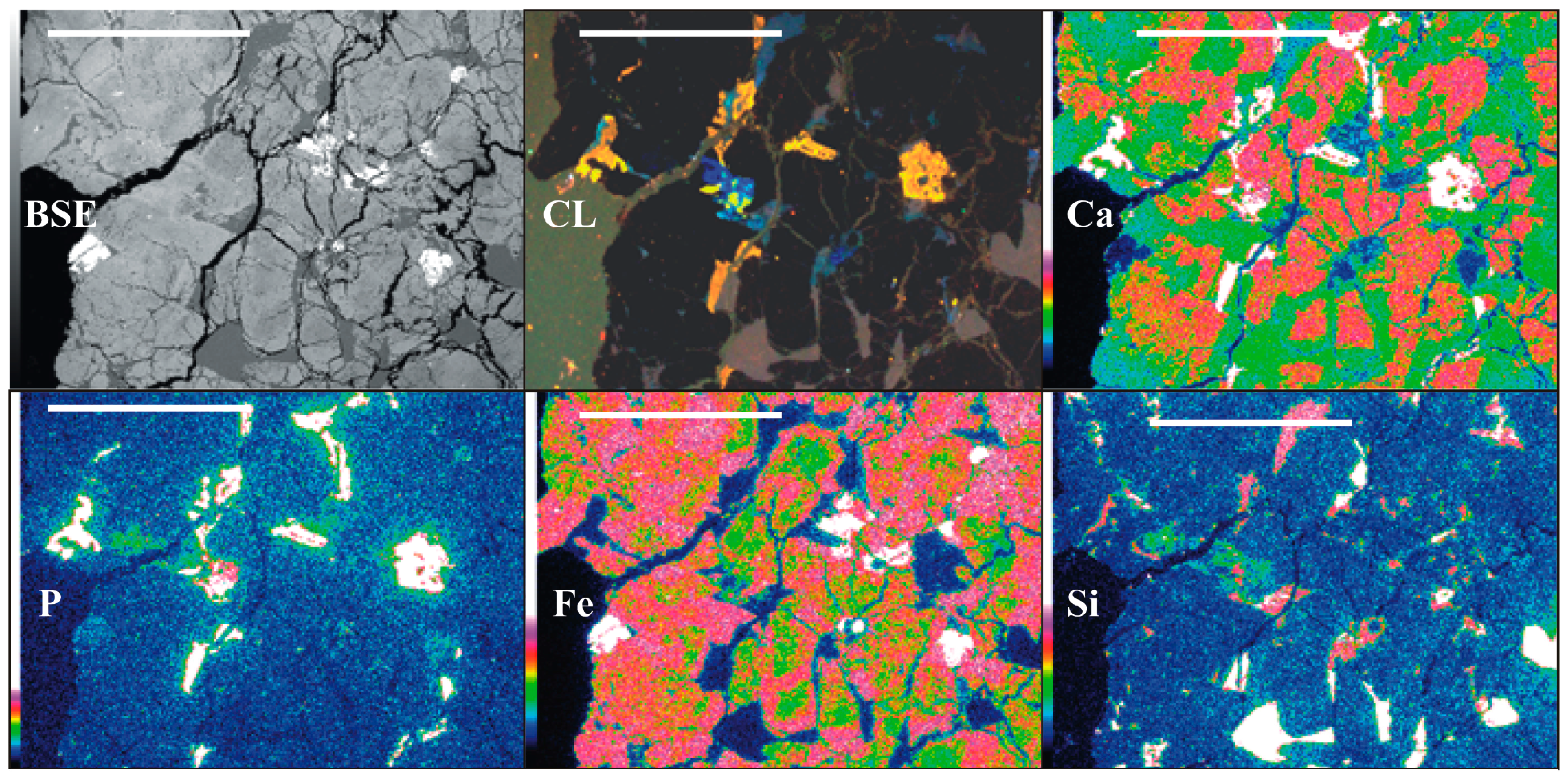

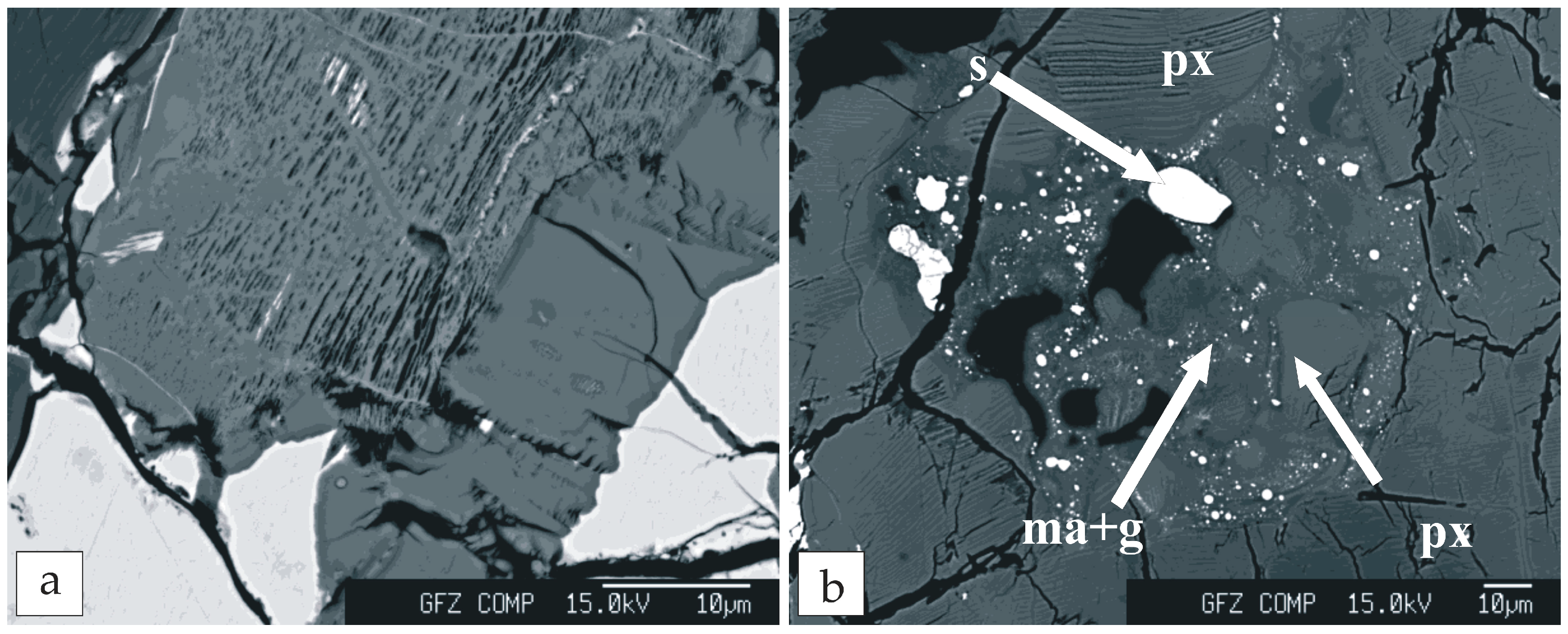
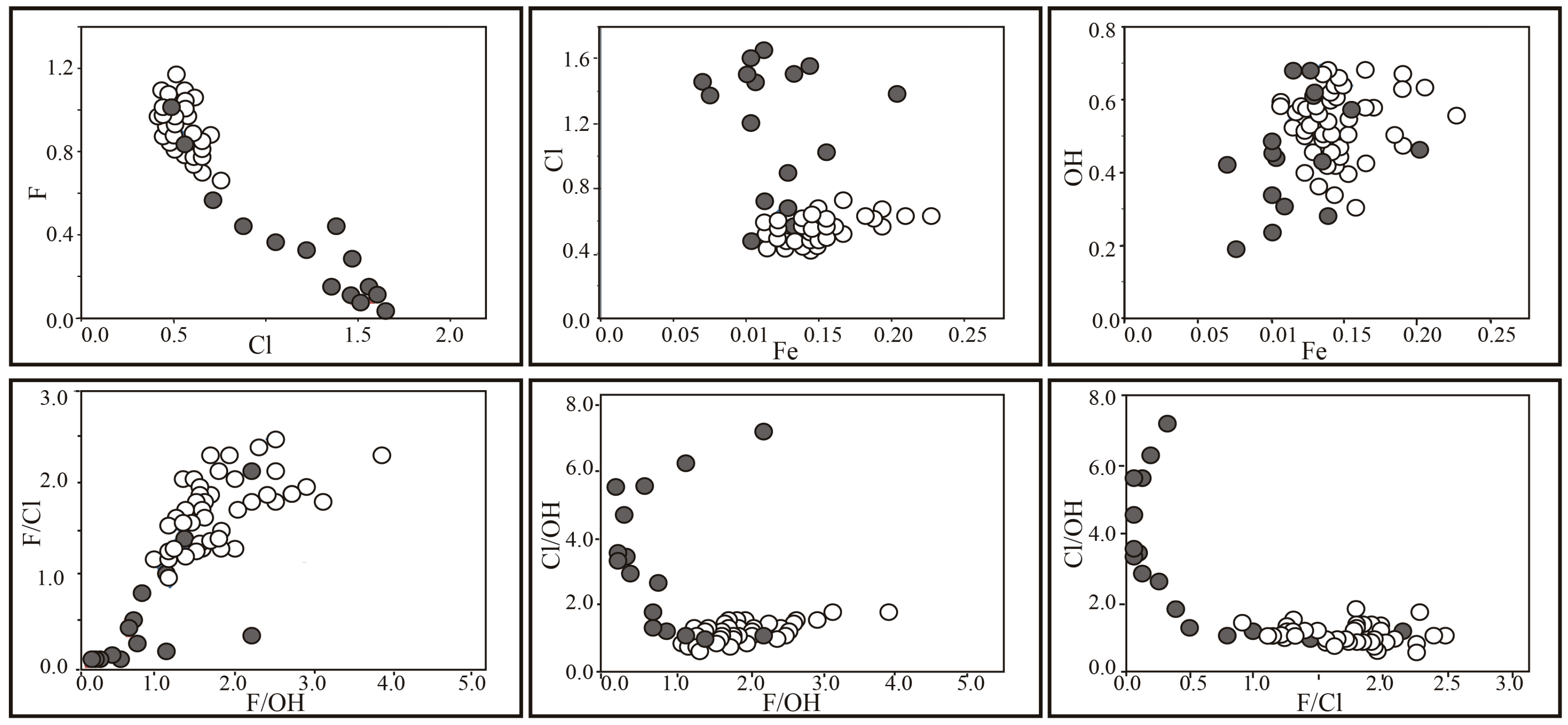
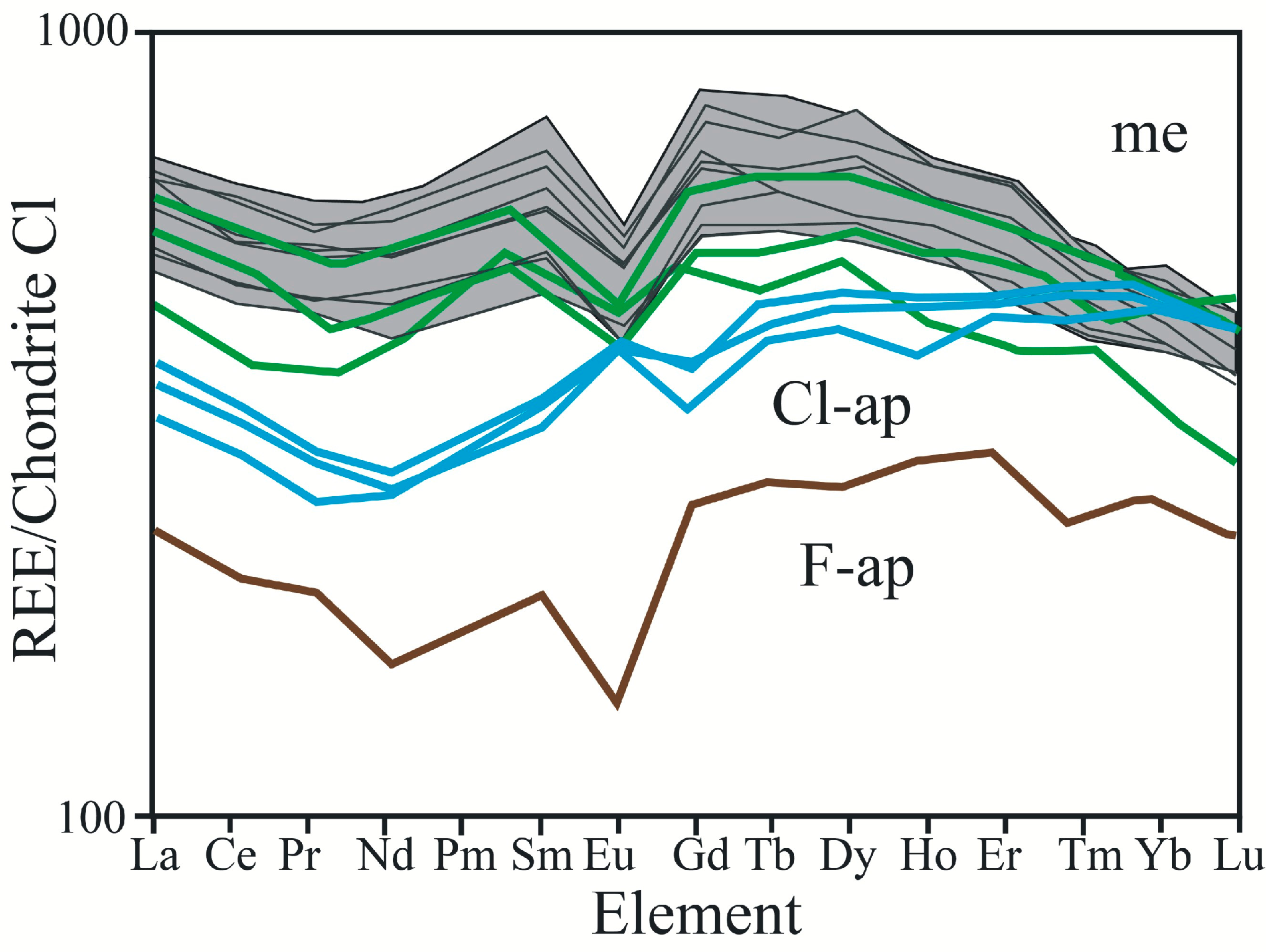
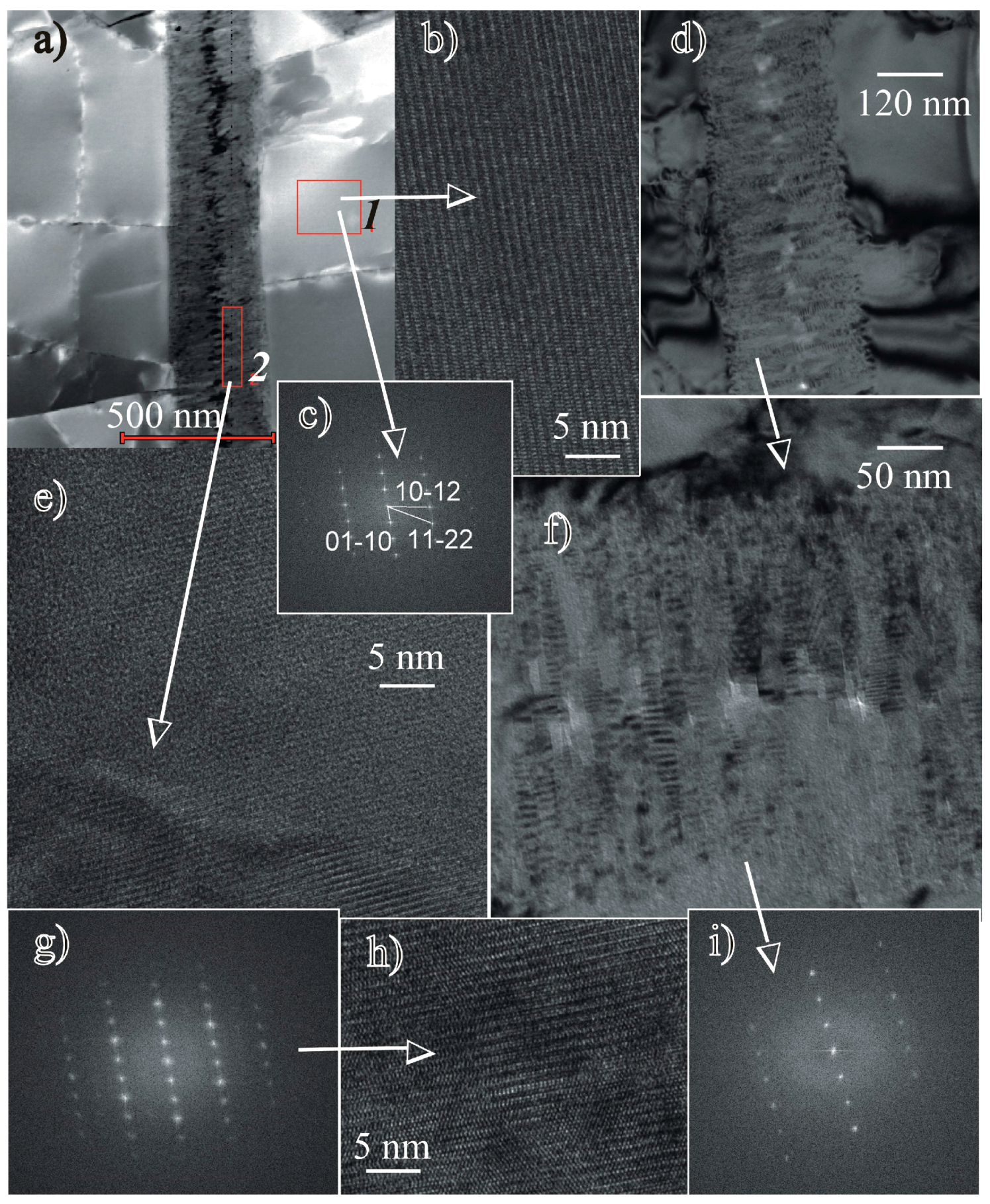
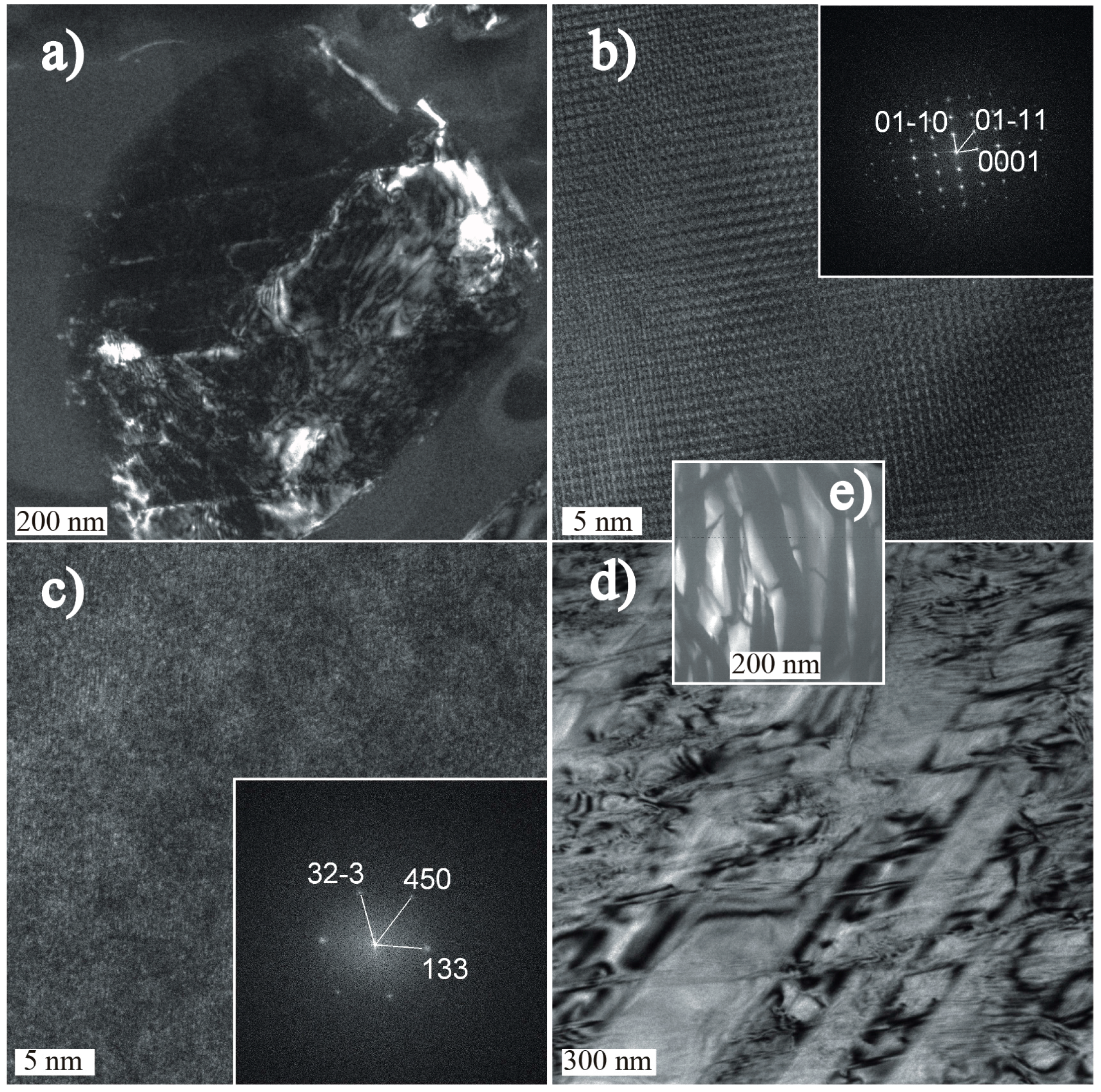
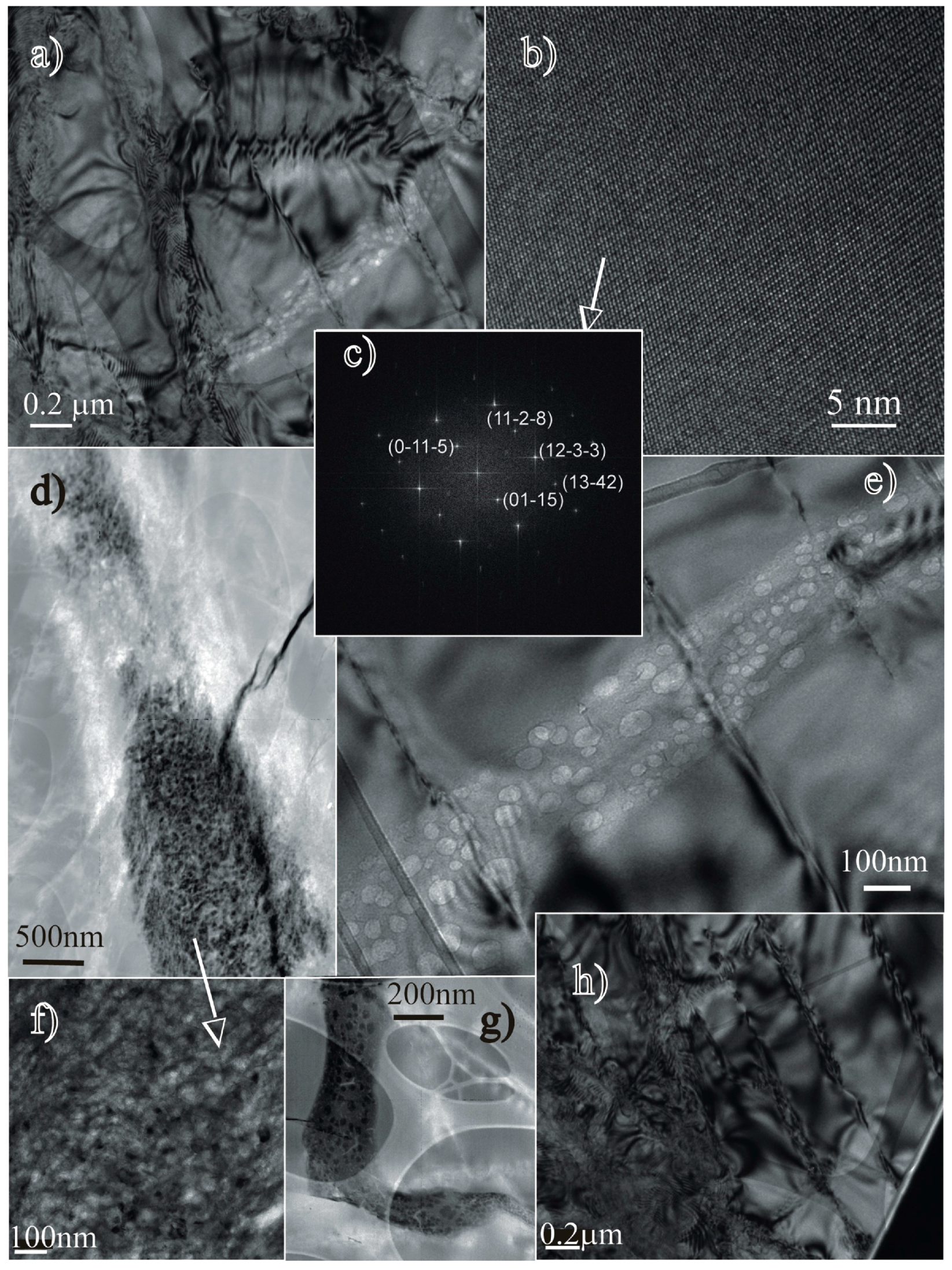

| Dhkl Observed (Å) | Indices | D-Spacing Calculated 1 |
| 8.13 | (-1102) | 8.0784 |
| 5.65 | (01-15) | 5.1789 |
| 5.18 | (11-20) | 5.1810 |
| 4.78 | (-1-123) | 4.7787 |
| 4.15 | (-2025) | 3.8396 |
| 3.89 | (10-19) | 3.7464 |
| 3.17 | (12-3-3) | 3.2710 |
| 2.63 | (21-39) | 2.6193 |
| 2.41 | (13-42) | 2.4668 |
| Angles Between Planes Observed | Angles Between Planes Calc. | FFT Nr. |
| (13-42)/(01-15) = 44.0° | (13-42)/(01-15) = 44.31° | HREM06 |
| (13-42)/(12-3-3) = 23.4° | (13-42)/(12-3-3) = 23.55° | |
| (-2025)/(-1-123) = 28° | (-2025)/(-1-123) = 27.94° | HREM06a |
| (-2025)/(-1102) = 52.6° | (-2025)/(-1102) = 52.38° | |
| (21-39)/(11-20) = 40.0° | (21-39)/(11-20) = 40.68° | HREM06b |
| (21-39)/10-19) = 28.3° | (21-39)/10-19) = 28.12° |
| Mineral | Average La Content (ppm) | Kd | Source | Melt Composition (ppm) |
| Apatite | 52 | 1.1 | [61] | 47 |
| Merrillite | 137 | 4.32 | GERM | 32 |
| Fe-Rich cpx | 0.048 | 0.001 | GERM | 48 |
| Mineral | Average Yb Content (ppm) | Kd | Source | Melt Composition (ppm) |
| Apatite | 39 | 2.3 | [61] | 17 |
| Merrillite | 73 | 8 | [61] | 9 |
| Fe-Rich cpx | 1.16 | 0.065 | GERM | 12 |
© 2017 by the authors. Licensee MDPI, Basel, Switzerland. This article is an open access article distributed under the terms and conditions of the Creative Commons Attribution (CC BY) license (http://creativecommons.org/licenses/by/4.0/).
Share and Cite
Słaby, E.; Förster, H.-J.; Wirth, R.; Wudarska, A.; Birski, Ł.; Moszumańska, I. Validity of the Apatite/Merrillite Relationship in Evaluating the Water Content in the Martian Mantle: Implications from Shergottite Northwest Africa (NWA) 2975. Geosciences 2017, 7, 99. https://doi.org/10.3390/geosciences7040099
Słaby E, Förster H-J, Wirth R, Wudarska A, Birski Ł, Moszumańska I. Validity of the Apatite/Merrillite Relationship in Evaluating the Water Content in the Martian Mantle: Implications from Shergottite Northwest Africa (NWA) 2975. Geosciences. 2017; 7(4):99. https://doi.org/10.3390/geosciences7040099
Chicago/Turabian StyleSłaby, Ewa, Hans-Jürgen Förster, Richard Wirth, Alicja Wudarska, Łukasz Birski, and Izabela Moszumańska. 2017. "Validity of the Apatite/Merrillite Relationship in Evaluating the Water Content in the Martian Mantle: Implications from Shergottite Northwest Africa (NWA) 2975" Geosciences 7, no. 4: 99. https://doi.org/10.3390/geosciences7040099





